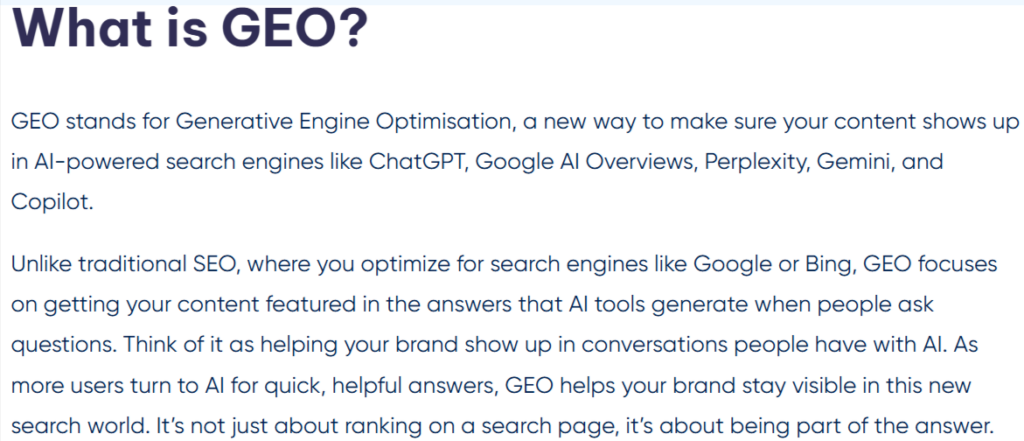
Content is the fuel behind every online campaign that drives traffic, clicks, and sales. But still, many marketers publish content that looks polished but fails to engage or convert.
This is not rare. A recent report from the Content Marketing Institute found that 55% of B2B marketers say creating content that triggers any action (like conversion or signup) is a major challenge.
That shows many teams still miss the mark. High-quality content is all about providing real value to the user without any ambiguity. In this guide, we are going to share what quality content actually is and some of the best tips to write high-quality content.
Jump ahead to:
What High-Quality Content Is and Why It Matters in Digital Marketing
According to Google, High-quality content is that which is helpful, reliable, and people-focused. This means the content that,
- Is original and authentic
- Answers real questions
- Provides accurate details
- Puts the reader’s needs first
When users read your content and find it useful, it is more likely that they will follow your brand. So such content increases your authority and builds your brand’s trust.
On the other hand, Google wants to rank the high-quality content that provides real value to its users. This indirectly enhances your SEO efforts. Higher rankings bring more traffic, which can turn into engagement, leads, and sales.
Best Tips to Write High-Quality Content
Here are some tips for creating high-quality content. These tips will help you attract readers, rank better on search engines, and help your business grow.
1. Know Your Target Audience Inside Out
The first thing in writing helpful content is to understand your target audience. You should identify your audience’s age, needs, goals, and buying intent.
If you use the wrong tone, style, or information, your content may not engage your audience, even if it is very useful. This could mean that you lose potential leads and conversions.
Almost every online platform has its own preferred content format and user base. So when writing content, you should keep in mind both the format of the platform and the interests of the users.
For example, beginners want step-by-step guidance. On the other hand, experts want insights and industry terms.
You can use competitor analysis, social listening, and surveys to get a detailed understanding of your audience. It will save you a lot of time and make your content strategy more focused and helpful.
2. Start With Strong, Clear Headlines
Headlines decide everything. If the headline looks weak, people are less likely to open or continue reading your post. They just scroll and move on.
A good headline must be clear first, so the reader knows what they will get in the first look. Then, add some power words (words that trigger emotions) that bring energy.
Curiosity also works well. But do not make it clickbait. Keep it short so it is easy to read at once. For example, a headline like
“5 Ways to Grow Sales Fast”
tells exactly what the post is about. Another example: look at this blog title:
It clearly shows that you are going to learn about optimizing your meta campaigns for business value. And the year mentioned shows that the information in this blog is the latest.
3. Write with Clarity and Concision
Writing with clarity means that when the user is reading your content, they understand your message easily, even if they are new to the topic. They do not have to read, stop and then think about what the author said here. And this can happen if you use fancy jargon, complex wording and phrases, passive voice, long sentences, etc.
So write in simple words, in the active voice. Use short, connected sentences. Keep the content concise. Do not add unnecessary fillers and fancy jargon just to sound sophisticated. Look at this part of the blog post:

This is the way to write as simply as possible. If you use any AI writing tool like ChatGPT to generate content, you must review and refine it for clarity. Even though AI-generated content looks fine, it frequently uses complex terms and has a robotic and excessively polished tone. Therefore, it fails to grab readers’ attention.
Wondering how one can spot such stiff wording? Well, you can do so manually by giving it multiple reads or with the help of AI text checker, which will automatically look for AI patterns in your provided content. You can easily work on the highlighted sections that sound robotic.
4. Ensure Originality and Credibility
Users trust and engage more with original content backed by credible sources. The Google E-E-A-T guidelines also emphasize it. Therefore, do not just copy the content from other sources and optimize it for personal use. Readers trust writing that looks original and honest.
So, always write content in your own words. Your word choice, writing tone, and style must always be brand-specific. If you want to add facts or references, use credible sources and cite them properly.
Share examples and explanations in your own style and tone, because it makes the text distinctive from thousands of other posts. This way, the content shows it is written by you and not copied.
Plus, to avoid any accidental plagiarism, you can check your content with a plagiarism checker to ensure the uniqueness of the content. And if you’re using AI tools for assistance, make sure your final draft sounds human-written – tools like bypass all AI detectors can help ensure your content passes AI detection checks while maintaining originality.
5. Optimize Content for SEO and Performance
Good content only works when people can find it and when it delivers results. For search, place keywords in the right spots, like in the title, headings, and naturally in the text. But do not stuff them. Optimize your content for mobile view and voice search, because in the future, people will use voice search more than ever.
Use long-tail keywords. These are highly specific and have lower search volume. But they are more likely to bring qualified leads and customers.
After publishing the content, it is necessary to track whether the content is connecting with the audience or not. Because there is no single roadmap for writing successful content. You have to check and optimize the content again and again. If you’re creating content from remote meetings or interviews, tools that offer zoom transcription can help you accurately capture discussions for repurposing into written assets.
Metrics like CTR, time on page, and conversions tell you about it. If one part is weak, the content must be fixed. You can use tools like Google Analytics, Search Console, and SEMrush to keep track of content progress and make changes to your content strategy.
Final Words
Content is the staple for all digital marketing platforms. It may be written, video, infographic, etc., but everything starts with writing the words. And writing high-quality content is the foundation of all your digital marketing campaigns.
So, follow all the tips mentioned above while writing content. Keep it concise and to the point. Make it authentic using your specific brand voice and personal experience. Include credible sources when providing information. All these things will collectively make your content helpful and attract and engage the users.








